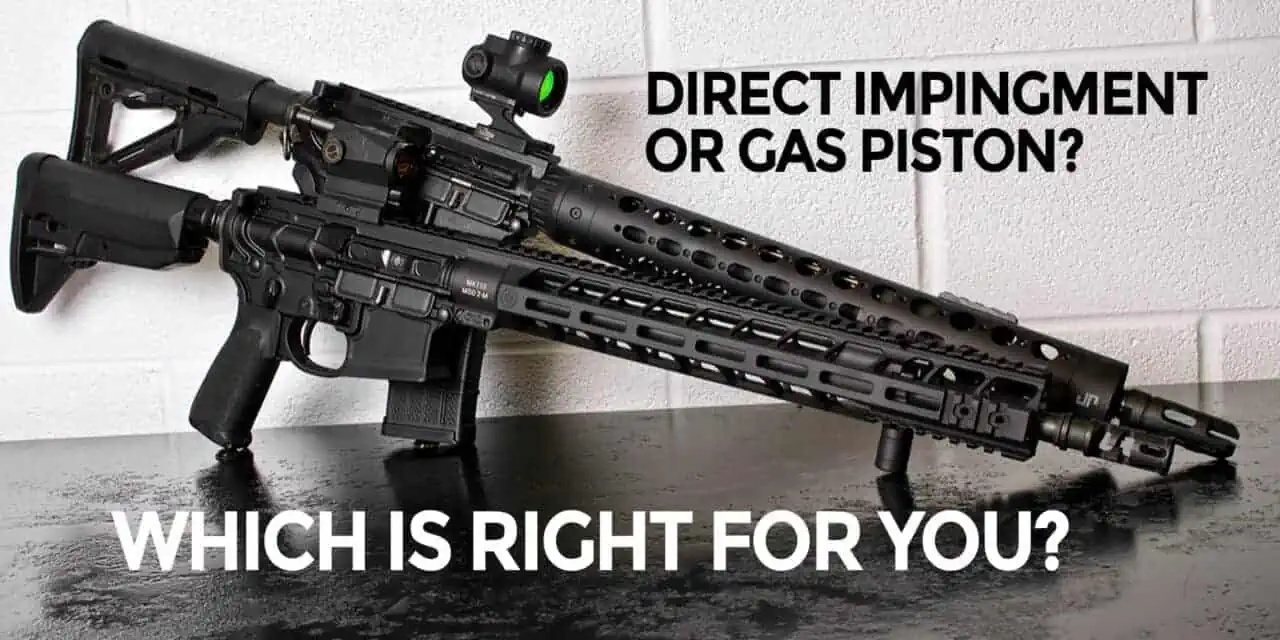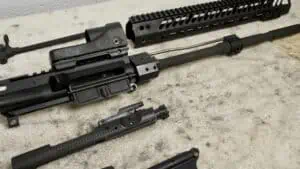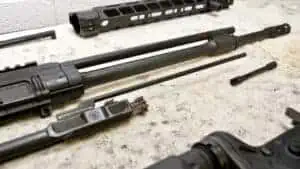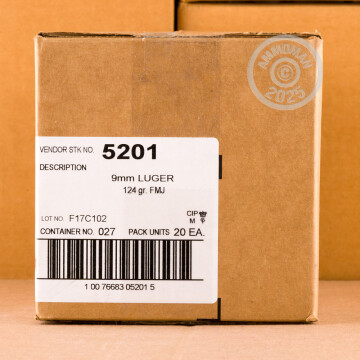Direct Impingement vs Gas Piston In An AR-15
I think we are in a golden age of guns. There are more choices today than ever before. For the most part, the choices are decisions regarding flavor. What I mean is the decisions don’t necessarily impact the outcome when you are running your gun. GLOCK, M&P, HK… Does it really matter? It’s like chocolate vs. vanilla in a lot of circumstances. In this example your answer might really just depend on what YOU like.
Of course, not all questions are as aimless as the one I posed above. Recently I was asked, “What are the advantages of direct impingement vs gas piston in an AR-15?”
It is a good question and I didn’t really have much to answer with other than my opinion. The question left me wondering about all the choices we have. I have to think that sometimes it would just be easier if we didn’t have so many choices. If there was just THE way to do something… but there isn’t. Instead, there are tons of options, and direct impingement vs gas piston is one of the choices we have to make.
The Direct Impingement AR
Direct impingement is the original design of the AR15. Stoner selected a gas operating system to help make the AR10 (and later the AR15) lighter than the piston operated M1 Garand and M14 that preceded these rifles. Interestingly enough, in “the beginning” the gas gun was the new and improved.
How a Direct Impingement AR15 Operates
The operation of a Gas AR15 is relatively simple. After the cartridge ignites the bullet is forced down the barrel by the hot gasses trapped in the barrel behind it. Eventually the bullet reaches a gas port in the top of the barrel, where gasses are able to escape but remain under pressure as the slug moves toward the muzzle.
This pressurized gas travels up through the gas block and into the gas tube that leads back to the upper receiver. The gas enters the upper where it meets the gas key on the bolt carrier group, travels down into the bolt, and expands in the expansion chamber. This unlocks the bolt, and the pressure from the gas sends the bolt and bolt carrier group to the rear. When the bullet leaves the barrel the dwell time (the period when the bullet is past the gas port but still in the barrel) ends and the bolt carrier group can begin its forward motion. This chambers a new round and locks the bolt in the barrel lugs.
This cycle repeats each time the trigger is pulled.
Advantages of Direct Impingement vs Gas Piston
There are some distinct positives to the way gas AR15s function.
Linear Operation
This is where the gas AR15 shines. The expanding gasses exert their forces in the bolt, which just happens to be neatly situated on the exact same axis as the barrel and the bolt carrier group. The result in a properly tuned rifle is a linear application of force on the rifle and long term durability. The recoil impulse is relatively straight back and tolerable, making the rifle fun and easy to shoot.
Light Weight
The AR15’s design eliminates moving parts, and as a result lends itself to a lighter weight operating system. The gas pushing on the bolt has much less mass than a metal rod doing the same job. Lighter is better when you are carrying a rifle, ammo, and other gear for miles and hours.
Accuracy
Modern AR15s with quality free floated barrels routinely outshoot their shooters. Many rifles are easily capable of holding sub-MOA groups. I like to hit what I’m aiming at, and the gas operated AR helps me get the hits.
Disadvantages of a Direct Impingement vs Gas Piston AR: Carbon, carbon, carbon…
Remember the gasses that do such a nice job operating the direct impingement AR15? They are also the yin to the yang I described above. When the gas expands in the bolt it isn’t just energy that it transfers. All the carbon from the cartridge’s ignition and the combustion of the powder stays behind long after the energy has dissipated. The result is a bolt carrier group covered in carbon and a potential loss of reliability.
The solutions aren’t rocket science… lube it and clean it.
The Gas Piston AR15
Frustrations with the reliability of the early AR15 had people looking for solutions. It’s hard to track the timeline on the first piston driven AR15, but we need to remember that guns actuated by operating rods have been common place for a long time. The AR was replacing piston guns and was seen as an inferior tool to the op rod AK-47, so it’s no surprise that the two would be combined.
How Does a Piston AR15 Operate?
Imagine the operation of the direct impingement AR described above and we just need to make a few changes. When the gas hits the gas block instead of traveling down a tube, the pressure of the gas is used to force a metal rod to the rear. The op rod, or piston, pushes on the gas key unlocking the bolt and sending the carrier to the rear.
Advantages of a Piston AR vs Direct Impingment
It’s pretty simple to sum up the reasons people go with piston AR15s. I talked with Eric Shafer of Black Boar Armory and Coatings. Eric spent a bunch of years in the United States Army working on M4s as an armorer. Now he owns a gun shop that specializes in NFA items and high end Cerakote work. After all those years working on gas guns, Eric’s favorite rifle is a piston operated PWS AR15.
“The piston in the PWS gives me confidence that my rifle is going to run. It doesn’t matter what ammo I’m running or whether I’m shooting suppressed or not. The rifle is going to fire when I press the trigger.” Shafer told me.
That is where the Piston shines. Piston guns stay cleaner because the gasses never get near the gun’s action. Instead, they stay near the gas block, making the guns easier to clean and more pleasant to shoot. This is especially true when barrels are short and suppressors constrict gasses at the muzzle.
Disadvantages of a Piston AR
But there is yin here too.
The piston guns are heavier. A hollow tube is replaced with a solid metal rod. This rod also exerts forces on the barrel that can cause accuracy issues. All that for a gun that is probably going to cost more than its DI counterpart…
Some argue that there may be even bigger issues with a piston gun. Back in 2012, I sat down with John Paul of JP Enterprises and we talked about the pros and cons of DI and piston guns. You can listen to our whole conversation here. John Paul builds and sells both, but he is clearly on the other side of the argument from Eric Shafer.
“With a piston gun you are trading one set of maintenance concerns for another set of maintenance concerns. This is why piston guns aren’t what the media has made them out to be.”
What was JP talking about? It’s simple: with a piston gun you are trading a dirty gun for carrier tilt.
Carrier Tilt
In a piston gun the operating rod is above the bore. When it pushes to the rear its forces are above the bolt carrier. When it pushes the bolt carrier backwards the bottom rear end of the bolt carrier is torqued down, which can lead to friction and wear on the lower receiver and the buffer tube. This is why the linear forces of the gas guns are so appreciated. No torque.
Companies like PWS have taken measures to reduce carrier tilt and avoid the negatives of it, so it isn’t a dealbreaker. But we need to understand it as one of the challenges piston guns present.
I’m pretty sure he wasn’t talking about AR15s, but I think Joe Jackson summed it up pretty well with these lyrics:
They say that choice is freedom
I’m so free it’s driving me insane
And you know why – it’s all too much…
Comparing A Direct Impingement vs Gas Piston AR-15
As I talked to experts around the industry it really seemed like I wasn’t going to find an answer to the question. There are compelling arguments on both sides of the gas AR vs. piston AR argument.
Joe Weyer runs the training facility at Alliance Police Training and heads his PD’s SWAT team. The team is 25 strong, spends hundreds of hours training annually, and has been involved in over 600 critical incidents and call outs in the last 25 years.
I listen to Joe.
This time he really caught my attention when he said, “ I have zero @%&$! to give. You are asking the wrong question. Does your gun work? Either it does or it doesn’t. That is what matters.”
I guess Joe Weyer could teach Joe Jackson a thing or two about all those choices. No reason to go insane. Make a choice and move on.
Gas gun or piston AR. Consider the pros and cons, make a choice, confirm that choice, and move on to something more important.
I was thinking about moving to a piston gun. I gotta be honest though, I haven’t had any issue with my gas guns. Time to move on to something more important.
What about you? What flavor do you prefer and why? What would convince you to make a change from a gas gun to a piston gun or vice versa? Or are you more of the mind to quit worrying so much about how your gun works and instead spend your effort on becoming a rifleman?






